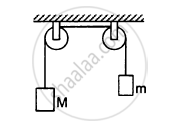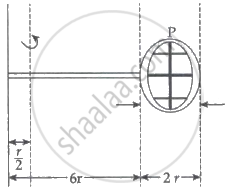Advertisements
Advertisements
Question
A solid cylinder rolls up an inclined plane of angle of inclination 30°. At the bottom of the inclined plane, the centre of mass of the cylinder has a speed of 5 m/s.
(a) How far will the cylinder go up the plane?
(b) How long will it take to return to the bottom?
Solution 1
Here, θ= 30°, v = 5 m/ s
Let the cylinder go up the plane up to a height h.
From 1/2 mv2 +1/2IW2 = mgh
`1/2 mv^2 + 1/2(1/2mr^2)omega^2 = mgh`
`3/4mv^2 = mgh`
`h = (3v^2)/(4g) = (3xx5^2)/(4xx9.8) = 1.913 m`
if s is the distance up the inclined plane, then as
`sin theta = h/s, s = h/(sin theta) = 1.913/sin 30^@ 3.856 m`
Time taken to return to the bottom
`t = sqrt((2s(1+k^2/r^2))/(g sin theta)) = sqrt((2xx 3826(1+1/2))/(9.8 sin 30^@)) = 1.53s`
Solution 2
A solid cylinder rolling up an inclination is shown in the following figure.

Initial velocity of the solid cylinder, v = 5 m/s
Angle of inclination, θ = 30°
Height reached by the cylinder = h
(a) Energy of the cylinder at point A:
`KE_"rot" = KE_"trans"`
`1/2 Iomega^2 = 1/2 mv^2`
Energy of the cylinder at point B = mgh
Using the law of conservation of energy, we can write:
`1/2Iomega^2 = 1/2mv^2 = mgh`
Moment of inertia of the solid cylinder, `I = 1/2 mr^2`
`:.1/2(1/2 mr^2)omega^2 + 1/2 mv^2 = mgh`
`1/4 mr^2 omega^2 + 1/2 mv^2 = mgh`
But we have the relation `v = romega`
`:.1/4v^2 + 1/2v^2 = gh`
`3/4 v^2 =gh`
`:.h = 3/4 v^2/g`
`= 3/4 xx (5xx5)/(9.8) = 1.91 m`
In `triangleABC`
`sin theta = (BC)/(AB)`
`sin 30^@ = h/(AB)`
`AB = (1.91)/0.5 = 3.82 m`
Hence, the cylinder will travel 3.82 m up the inclined plane.
(b) For radius of gyration K, the velocity of the cylinder at the instance when it rolls back to the bottom is given by the relation:
`v = ((2gh)/(1+K^2/R^2))^(1/2)`
`:.v = ((2gABsin theta)/(1+K^2/R^2))^(1/2)`
For the soild cylinder, `K^2 = R^2/2`
`:.v = ((2gABsin theta)/(1+1/2))^(1/2)`
`= (4/3gABsin theta)^(1/2)`
The time taken to return to the bottom is:
`t = (AB)/v`
`= (AB)/(4/3gABsintheta)^(1/2) =((3AB)/(4gsintheta))^"1/2"`
`=(11.46/19.6)^(1/2) = 0.764 s`
Therefore, the total time taken by the cylinder to return to the bottom is (2 × 0.764) 1.53 s.
APPEARS IN
RELATED QUESTIONS
A rope of negligible mass is wound round a hollow cylinder of mass 3 kg and radius 40 cm. What is the angular acceleration of the cylinder if the rope is pulled with a force of 30 N? What is the linear acceleration of the rope? Assume that there is no slipping.
A body having its centre of mass at the origin has three of its particles at (a,0,0), (0,a,0), (0,0,a). The moments of inertia of the body about the X and Y axes are 0⋅20 kg-m2 each. The moment of inertia about the Z-axis
Let IA and IB be moments of inertia of a body about two axes A and B respectively. The axis A passes through the centre of mass of the body but B does not.
Suppose the smaller pulley of the previous problem has its radius 5⋅0 cm and moment of inertia 0⋅10 kg-m2. Find the tension in the part of the string joining the pulleys.
The pulleys shown in the following figure are identical, each having a radius R and moment of inertia I. Find the acceleration of the block M.

A wheel of moment of inertia 0⋅500 kg-m2 and radius 20⋅0 cm is rotating about its axis at an angular speed of 20⋅0 rad/s. It picks up a stationary particle of mass 200 g at its edge. Find the new angular speed of the wheel.
A boy is seated in a revolving chair revolving at an angular speed of 120 revolutions per minute. Two heavy balls form part of the revolving system and the boy can pull the balls closer to himself or may push them apart. If by pulling the balls closer, the boy decreases the moment of inertia of the system from 6 kg-m2 to 2 kg-m2, what will be the new angular speed?
Why does a solid sphere have smaller moment of inertia than a hollow cylinder of same mass and radius, about an axis passing through their axes of symmetry?
Moment of inertia (M.I.) of four bodies, having same mass and radius, are reported as :
I1 = M.I. of thin circular ring about its diameter,
I2 = M.I. of circular disc about an axis perpendicular to disc and going through the centre,
I3 = M.I. of solid cylinder about its axis and
I4 = M.I. of solid sphere about its diameter.
Then -
Consider a badminton racket with length scales as shown in the figure.

If the mass of the linear and circular portions of the badminton racket is the same (M) and the mass of the threads is negligible, the moment of inertia of the racket about an axis perpendicular to the handle and in the plane of the ring at, `r/2` distance from the ends A of the handle will be ______ Mr2.
